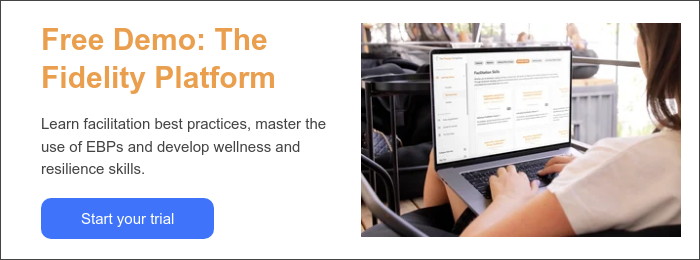Building program culture: Best practices for developing a program-supportive environment in the justice system

You likely already know that program culture has a key influence on participant outcomes. How do you build and implement successful programs – especially when staff are spread thin and employee engagement is a challenge?
To build a program-supportive institution, there are a few essential benchmarks:
- Staff and participants are supportive.
All staff know what programs are available and what the purposes of those programs are. Participants are involved in implementation and value the programs offered to them. - Programs are considered a priority.
Programs are canceled only as a last resort. Adjustments are made to keep programs running smoothly. - Decisions are made with programs in mind.
Big changes elsewhere in the institution, including participant movement, are made in conjunction with programming whenever possible.
Three phases to build a healthy program culture
Preparation Stage
Take your time to build a healthy foundation.
- Assess need: Consider demographics such as age, gender and education level, as well as time to reentry and criminogenic needs.
- Assess resources: Can you ensure your staff have time for programs? Do you have the budget for necessary materials?
- Select program/curricula: Select curricula that are in line with both the needs you assessed and the resources available to you.
Pro-tip: Make it a system-wide initiative. A challenge in the early stages of building a program culture is that only select staff are involved in the programming conversation. Just as system-wide decisions should be made with programs in mind, the entire system of staff should be involved in the program conversation.
Implementation Stage
You’ve laid the groundwork – now it’s time to get the ball rolling.
- Train your staff. Take your time when training to ensure your entire team has time to practice and get comfortable with the material. Overtraining is a good thing — staff move around, so making sure more than your core team are familiar with the program will save you headaches in the long run.
- Celebrate an official kick-off. Pick an official launch date and get your staff, leadership and participants involved and excited.
- Pilot each program. If you have a large institution, pick one area to focus on first and work out the inevitable kinks of the program. Taking your time with a pilot program can make implementing a system-wide initiative smoother and easier for staff and participants.
Pro Tip: Train the “why” in addition to the “how.” The last thing you want is for programming to become just one more task for your staff to complete. Involve them throughout the process and explain why these programs are important.
Pro Tip: Don’t forget to include the end user from the beginning. To avoid participants showing up physically but not committing to the program, give them some say and involvement in the programming process.
Pro Tip: There’s always that one person – don’t get locked in a power struggle. Sometimes that squeaky wheel just needs to be heard. Give your staff the opportunity to ask: what’s in it for me? Once they’re able to voice their concerns and have their questions answered, they might just become your program’s biggest supporters.
Post-implementation
Building a successful program culture involves regular maintenance.
- Conduct regular follow-ups. Catching potential problems early can be essential for the long-term health of your programs.
- Utilize hard data. Gather statistics from the very beginning on completion rates, participant satisfaction and other key metrics. Share this data with your team to let them know what they’re doing well and where adjustment can be made.
- Share anecdotal data. Success stories can be highly motivating for staff and future participants. Satisfied participants are your best advocates!
- Celebrate program milestones. Keep the momentum going that you built with the kick-off. Celebrate with staff and participants when curricula are completed and benchmarks are hit.
Pro Tip: It may happen that some areas (shifts, units, complexes) are highly invested while others aren’t. Create some healthy competition! Use the hard and anecdotal data to highlight those who are doing well and encourage the whole system.
Know that you can build a positive program culture and employee engagement in your institution. For more, check out our webinar on Program Culture with clinical director Caitlin Matekel and senior training consultant (and former Arizona DOC division director of inmate programs and reentry) Karen Hellman.
At The Change Companies, we’re here to not only help your participants, but also to walk alongside providers and facilitators and make your job as streamlined as possible.

